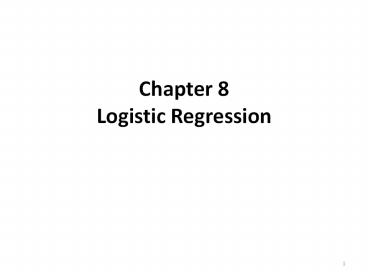Chapter 8 Logistic Regression - PowerPoint PPT Presentation
Title:
Chapter 8 Logistic Regression
Description:
Chapter 8 Logistic Regression * Introduction Logistic regression extends the ideas of linear regression to the situation where the dependent variable, Y , is categorical. – PowerPoint PPT presentation
Number of Views:312
Avg rating:3.0/5.0
Title: Chapter 8 Logistic Regression
1
Chapter 8 Logistic Regression
2
Introduction
- Logistic regression extends the ideas of linear
regression to the situation where the dependent
variable, Y , is categorical. - A categorical variable as divides the
observations into classes. - If Y denotes a recommendation on holding /selling
/ buying a stock, then we have a categorical
variable with 3 categories. - Each of the stocks in the dataset (the
observations) as belonging to one of three
classes the hold" class, the sell" class, and
the buy class. - Logistic regression can be used for classifying a
new observation into one of the classes, based on
the values of its predictor variables (called
classification"). - It can also be used in data (where the class is
known) to find similarities between observations
within each class in terms of the predictor
variables (called profiling").
3
Introduction
- Logistic regression is used in applications such
as - 1. Classifying customers as returning or
non-returning (classification) - 2. Finding factors that differentiate between
male and female top executives (profiling) - 3. Predicting the approval or disapproval of a
loan based on information such as credit scores
(classification). - In this chapter we focus on the use of logistic
regression for classification. - We deal only with a binary dependent variable,
having two possible classes. - The results can be extended to the case where Y
assumes more than two possible outcomes. - Popular examples of binary response outcomes are
- success/failure,
- yes/no,
- buy/don't buy,
- default/don't default, and
- survive/die.
- We code the values of a binary response Y as 0
and 1.
4
Introduction
- We may choose to convert continuous data or data
with multiple outcomes into binary data for
purposes of simplification, reflecting the fact
that decision-making may be binary - approve the loan / don't approve,
- make an offer/ don't make an offer)
- Like MLR, the independent variables X1,X2, ,Xk
may be categorical or continuous variables or a
mixture of these two types. - In MLR the aim is to predict the value of the
continuous Y for a new observation - In Logistic Regression the goal is to predict
which class a new observation will belong to, or
simply to classify the observation into one of
the classes. - In the stock example, we would want to classify a
new stock into one of the three recommendation
classes sell, hold, or buy.
5
Logistic Regression
- In logistic regression we take two steps
- the first step yields estimates of the
probabilities of belonging to each class. - In the binary case we get an estimate of P(Y
1), - the probability of belonging to class 1 (which
also tells us the probability of belonging to
class 0). - In the next step we use
- a cutoff value on these probabilities in order to
classify each case to one of the classes. - In a binary case, a cutoff of 0.5 means that
cases with an estimated probability of P(Y 1) gt
0.5 are classified as belonging to class 1, - whereas cases with P(Y 1) lt 0.5 are classified
as belonging to class 0. - The cutoff need not be set at 0.5.
6
Logistic Regression
- Unlike ordinary linear regression, logistic
regression does not assume that the relationship
between the independent variables and the
dependent variable is a linear one. - Nor does it assume that the dependent variable or
the error terms are distributed normally.
7
Logistic Regression
- The form of the model is
where p is the probability that Y1 and X1, X2,..
.,Xk are the independent variables (predictors).
b0 , b1, b2, .... bk are known as the regression
coefficients, which have to be estimated from the
data. Logistic regression estimates the
probability of a certain event occurring.
8
Logistic Regression
- Logistic regression thus forms a predictor
variable (log (p/(1-p)) which is a linear
combination of the explanatory variables. - The values of this predictor variable are then
transformed into probabilities by a logistic
function. - Such a function has the shape of an S.
- See the graph on the next slide
- On the horizontal axis we have the values of the
predictor variable, and on the vertical axis we
have the probabilities. - Logistic regression also produces Odds Ratios
(O.R.) associated with each predictor value.
9
(No Transcript)
10
Logistic Regression
- The "odds" of an event is defined as the
probability of the outcome event occurring
divided by the probability of the event not
occurring. - In general, the "odds ratio" is one set of odds
divided by another. - The odds ratio for a predictor is defined as the
relative amount by which the odds of the outcome
increase (O.R. greater than 1.0) or decrease
(O.R. less than 1.0) when the value of the
predictor variable is increased by 1.0 units. - In other words, (odds for PV1)/(odds for PV)
where PV is the value of the predictor variable.
11
Logistic Regression
- The logit as a function of the predictors
The probability as a function of the predictors
The odds as a function of the predictors
12
The Logistic Regression Model
- Example Charles Book Club
13
Problems
- Financial Conditions of Banks
- Identifying Good Systems Administrators































